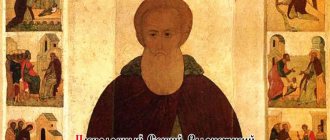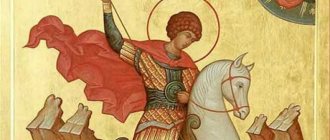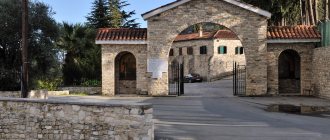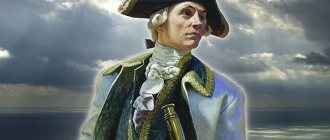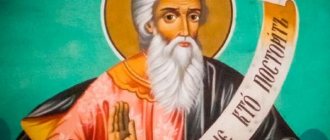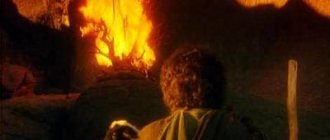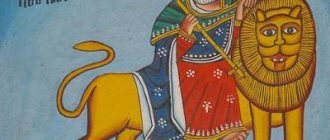On November 29, on the second day of the Nativity Fast, the Orthodox Church remembers the holy apostle and evangelist Matthew, one of the twelve closest disciples of Christ. We know very little about the Apostle Matthew (Levi Matthew, as he is also called), although he is the author of the Gospel with which the New Testament begins. What is known for certain is that he was a publican, that is, a collector of customs duties, and also the brother of another apostle, James. Their father's name was Alfey, hence his other name: Levi Alfeev.
He lived in Galilee, in the town of Capernaum, which was located on the road connecting two large cities - Caesarea and Damascus. In towns such as Capernaum, customs points were established in those days, where duties were collected from all travelers and traders passing along the road. This is what the publicans did, who at that time were very wealthy people. However, this occupation was considered unworthy and despised in society. After all, publicans worked for the city administration, that is, for the Roman occupiers, robbing their fellow citizens. In addition, they collected their labor, honestly earned money not only into the treasury, but also into their own pockets.
Apostle Matthew in art
The Apostle Matthew is depicted quite often in iconography and fine arts. This is explained by its essential significance in spreading the word of God.
For example, it is worth paying attention to the wonderful work “Apostle Matthew and the Angel” by the Italian painter of the Bolognese school, the magnificent master of the Baroque Reni Guido (November 4, 1575, Calvenzano - August 18, 1642, Bologna). He studied with Carracci and Ferrantini, was a graduate of the Bologna Academy of Arts, a guide and heir to its pictorial tradition and pedagogical system.
Guido Reni. Apostle Matthew and the angel, 1635-1640. Vatican Pinacoteca, Rome
Among the outstanding masterpieces of painting are three amazing paintings from the life of the apostle by the great Caravaggio (Italian Michelangelo Merisi da Caravaggio; September 29, 1571, Milan - July 18, 1610, Porto Ercole) - an Italian artist, reformer of European painting of the 17th century, founder of realism in painting , one of the greatest masters of the Baroque.
Caravaggio. The calling of the Apostle Matthew. Fragment. 1598-1601 Rome, Church of San Luigi dei Francesi
Gospel of Matthew
After the Ascension of the Lord and the descent of the Holy Spirit on the Apostles, Saint Matthew first preached for 8 years in Palestine. But now the time has come for the Apostles to disperse from Jerusalem to different nations. Mainly to convert them to the faith of Christ. Before the Apostle's departure from Jerusalem, the Jewish Christians of Jerusalem asked him to hand over for them the writings of the deeds and teachings of Jesus Christ. The other Apostles who were in Jerusalem at that time also expressed their consent to the fulfillment of this request. And Saint Matthew, fulfilling the common desire, wrote the Gospel, 8 years after the Ascension of Christ.
The Gospel of Matthew was written around 41 AD. This is the first Holy Book of all the books of the New Testament and, therefore, occupies first place among them. The place where the Gospel was written is called Palestine. The Gospel was written in Hebrew, or in the Aramaic dialect then used. It was then translated into Greek.
Features of the Gospel of Matthew
It was originally intended for Palestinian Jewish Christians. The narratives in the Gospel of Matthew are aimed primarily at showing that Jesus is the true Messiah, promised to the forefathers of the Jewish people, and there will be no other (Matthew 11:3). Therefore, in the Gospel of Matthew, more often than in other Gospels, not only events from the life of Christ are compared with Old Testament prophecies and types.
But from the entire history of Christ the Savior, narratives that are especially important and necessary for the Jews are selected. That is why Matthew begins his Gospel with the genealogy of the Messiah as the son of David and Abraham. Thus showing that Jesus is not a spirit or an Angel, as some later believed, but flesh of the flesh of the Israeli people. Moreover, the continuation of his story and the fulfillment of the promises made to him.
This distinctive feature of the Gospel of St. Matthew is also expressed in his icons. On them he is depicted together with an Angel-like man, symbolically characterizing the features of his Gospel.
Caravaggio. The Calling of the Apostle Matthew
Mathieu Contrel (building contractor) left a will. According to him, it was necessary to decorate the chapel in the church with frescoes. He chose a specific topic and the required quantity. The contract was signed with the then famous painter Cesari d'Arpino. He was once a rival of Caravaggio. But since he was simply inundated with all kinds of orders, in 1599 he was only able to design the vault. There were serious concerns that the painting would not be completed in the required time.
The agreement with d'Arpino was broken. We decided to entrust this important matter to Caravaggio. Before that, he dealt only with private orders. This work became his first attempt at writing for a wide audience. The painter decided to completely abandon traditional frescoes. He preferred large canvases.
“The Calling of the Apostle Matthew” is the first painting. This work of the artist is rightfully the best creation, created on a rather rare subject.
Jesus himself saw Matthew and decided to call him to serve as an apostle. Caravaggio's interpretation is different. He depicts this plot as one of the scenes of ordinary life of that time. We see a dark room. People sit and count the proceeds. The young people turned around and looked attentively at those who entered. Matvey is dressed poorly. No one understood who he was except Levi.
The darkness is broken by a stream of light in the place where Jesus is with the Apostle Peter. This is a symbol of faith that suddenly burst into the world. Our gaze is strictly organized by the way it is directed. We involuntarily read the entire scene precisely, starting from the left. We can only see the hand and head of Jesus. He only came here for a minute, as his feet were turned towards the exit. Here the same gesture is repeated three times - an outstretched arm. Many researchers believe that this is no coincidence.
Michelangelo Caravaggio. Martyrdom of the Apostle Matthew. 1599-1602. San Luigi dei Francesi, Rome
Holy Publican from Capernaum
November 29 marks the day of remembrance of Matthew Levi, one of the twelve apostles, the closest disciple of Jesus Christ.
The holy apostle and evangelist Matthew (which means “gift of God”), son of Alpheus, lived in the Galilean city of Capernaum, which lay on the northwestern shore of the Sea of Galilee. Before his call to the apostleship he was called Levi, after which he was better known under the name Matthew. According to Blessed Jerome, his common name was Matthew, and his more honorable name, as if literary and religious, was Levi. The apostles, out of respect for him, call him by his best name, and he himself constantly calls himself Matthew, without being ashamed to talk about his former position, so despicable in the eyes of his compatriots. Matthew was a publican, that is, a tax collector for Rome.
Tax collector Matthew, before his calling by Christ
The people were predominantly selfish and cruel; publicans were considered by the Jews to be traitors to the people and apostates from God. Talking to a tax collector was considered a sin, and entering their houses was considered desecration. However, among the tax collectors there were good and God-fearing people. So was the future Apostle Matthew. Clement of Alexandria reports that Saint Matthew did not eat meat throughout his entire life, but ate only greens and fruits. Matthew, like everyone like him, was despised by his compatriots. But the Lord fixed His Divine gaze on him, despised by everyone. The conversion and calling of the publican was probably prepared by the very circumstances of his life: Matthew more than once had the opportunity to hear the teaching of Jesus Christ in Capernaum, and witnessed His numerous miracles. In the Gospel, which was written by Matthew eight years after the Ascension of Christ, the apostle sets out the story of his calling. Once, during His stay in Capernaum, the Lord left the city and, accompanied by the people, headed to the sea along the caravan road. Matthew, who was collecting duties from merchants passing here, was sitting near his tollhouse: “...Jesus saw a man sitting at the collection office named Matthew, and said to him: follow me. And he arose and followed Him” (Matthew 9:9).
Jesus Christ calls the publican Levi
Turning to Matthew with this appeal, the Knower of the Heart knew that this publican would be His chosen vessel. Matthew, without hesitation, got up and left, leaving everything. He distributed his property to the poor and, together with the other apostles, followed Christ. And now he never left Him again. Soon Matthew was awarded by the Lord to be numbered among the twelve chosen apostles, being chosen to take the place of the fallen Judas. Together with other disciples of the Lord, Matthew accompanied Him on travels through Galilee and Judea, listened to His Divine teaching, saw countless miracles performed by Jesus Christ, went preaching to the lost sheep of the house of Israel, witnessed the suffering on the cross and the atoning death of the Savior and His ascension into heaven .
Cathedral of the Twelve Apostles, Byzantine icon, early 14th century
After the Ascension of the Lord and the descent of the Holy Spirit on the apostles, Saint Matthew remained in Palestine for eight years, together with the other apostles, preaching the Gospel in Jerusalem and its environs. When the time came for the apostle to leave Jerusalem for distant countries to convert peoples to the faith of Christ, the Jewish Christians of Jerusalem asked him to leave for them a written testimony about the life and teachings of Jesus Christ. This request was supported by the other apostles who were in Jerusalem at that time. In terms of the time of its writing, this is the earliest of all four Gospels, therefore, among the books of the New Testament, the Gospel of Matthew comes first.
Apostle Matthew writes the Gospel
The place where the Gospel was written is called Palestine. It is believed that the Gospel was written by Saint Matthew at the request of the Jerusalem Christians at a time when, as a result of the strong persecution brought upon them, they were in danger of being scattered, and they wanted, wherever they were to be, to have with them a true story about earthly life and teachings of the God-man Jesus Christ. It is possible that the writing of the Gospel began at the time of the said persecution and was completed by the time the apostles left to preach in different countries.
Gospel of Matthew. Genealogy of Jesus Christ. England, XIV century
Tree of Jesse Gospel of Matthew: chapter 1.1-17 1 Genealogy of Jesus Christ, Son of David, Son of Abraham. 2 Abraham begat Isaac; Isaac gave birth to Jacob; Jacob begat Judah and his brothers; 3 Judah begat Perez and Zerah by Tamar; Perez begat Hezrom; Hezrom begat Aram; 4 Aram begot Abinadab; Amminadab begat Nahshon; Nahshon begat Salmon; 5 Salmon begat Boaz by Rahab; Boaz fathered Obed by Ruth; Obed begat Jesse; 6 Jesse begat David king; David the king begot Solomon from Uriah; 7 Solomon begat Rehoboam; Rehoboam gave birth to Abijah; Abijah begat Asa; 8 Asa begat Jehoshaphat; Jehoshaphat begat Joram; Jehoram begat Uzziah; 9 Uzziah begat Jotham; Jotham begat Ahaz; Ahaz begat Hezekiah; 10 Hezekiah begat Manasseh; Manasseh begat Amon; Amon gave birth to Josiah; 11 Josiah begat Joachim; Joachim gave birth to Jeconiah and his brothers before moving to Babylon. 12 After he was removed to Babylon, Jeconiah begat Shealtiel; Shealtiel begat Zerubbabel; 13 Zerubbabel begat Abihu; Abihu begat Eliakim; Eliakim begat Azor; 14 Azor begat Zadok; Zadok gave birth to Achim; Achim begat Eliud; 15 Eliud begat Eleazar; Eleazar begat Matthan; Matthan gave birth to Jacob; 16 Jacob begat Joseph, the husband of Mary, from whom was born Jesus, who is called Christ. 17 So all the generations from Abraham to David are fourteen generations; and from David to the deportation to Babylon, fourteen generations; and from the migration to Babylon to Christ there are fourteen generations.
Matthew wrote his Gospel in the Syrochaldean (or Aramaic) language, which was spoken by Palestinian Jews at that time, but in Hebrew letters, as Blessed Jerome notes. Later the Gospel was translated into Greek, and the Hebrew original was lost. There is a legend that the Evangelist Matthew himself translated the Gospel from the Hebrew. According to another version, the translation was made by the evangelist John the Theologian. One thing is certain: the Greek translation (which is recognized as canonical, since the Syrochaldean text was distorted by heretics) was made during the time of the apostles.
St. Evangelist Matthew. Icon. Byzantium. XIV century. Macedonia
Having left Jerusalem, the holy Apostle Matthew went around Macedonia, Syria, Persia, Parthia, and Media with the gospel. Finally, guided by the Holy Spirit, he came to Ethiopia. This country was inhabited by beast-like black people - cannibals. In a city called Myrmene, the apostle converted several idolaters to faith in Christ, founded a small church for the converts, and installed his companion Plato as bishop. He himself retired to a nearby mountain and remained in fasting, earnestly praying to the Lord for the conversion of the Ethiopians. And then the Lord appeared to him in the form of a beautiful young man, with a rod in his hand. He commanded the apostle to come down from the mountain and plant the staff at the door of the church created in Mirmeni. “This rod,” said the Lord, “by My power will grow into a tall tree, which will bear abundant fruit, surpassing in size and sweetness all other garden fruits; and from its root will flow a spring of pure water. Having washed in it, the cannibals will receive a beautiful face, and anyone who has tasted the fruit will forget their brutal morals and become a kind and meek person.” Having accepted the rod from the hands of the Lord, the Apostle Matthew went down and went into the city to fulfill the command. On the way, he met the wife and son of the local prince Fulvian, possessed by an unclean spirit. “Who sent you with this rod to our destruction?” - they shouted in wild, threatening voices. Matthew, in the name of Christ, cast out unclean spirits and healed those possessed by demons. Both those healed bowed to the apostle and meekly followed him. This miracle converted many more pagans to the Lord.
Meeting of Matthew with his wife and son Fulvian
Having learned about his arrival, at the entrance to the city the apostle was already met by Bishop Plato and the clergy. They all went to the temple and did as the Lord commanded: they stuck a rod into the ground, and it immediately grew into a large tree, and beautiful fruits appeared on it, large and sweet, and a babbling stream of crystal water flowed from the root. Everyone who saw this was amazed. Then the entire population of the city gathered at the temple, people drank water and ate fruits. The Apostle Matthew, standing on an elevated place, preached the Word of God to those gathered in their language. All those present there believed in Christ, and the Apostle baptized them in a miraculous spring. And all the baptized cannibals, according to the word of the Lord, became beautiful in complexion and lost the blackness of their skin. Among those who believed and were baptized were the wife and son of ruler Fulvian. Having learned about what had happened, the prince at first rejoiced at the healing of his wife and son, but then, seeing that the people were leaving idols and going to the apostle to be baptized, he became angry with Matthew and planned to destroy him. That same night the Savior appeared to the evangelist and commanded him to strengthen his spirit, promising not to leave him in the coming sorrows. When morning came and the apostle, having risen from sleep, was praying in the temple with the believers, the prince sent four soldiers to arrest the saint. As soon as they arrived, darkness immediately enveloped them, so that they could hardly return back. The soldiers said in fear: “We heard his voice, but we could not only take him, but also could not see him.” Fulvian became even more angry. This time he sent even more armed soldiers to the temple, ordering Matthew to be brought at all costs. But these warriors also returned with nothing. The heavenly light shone on the apostle, and the guards, unable to look at him, threw down their weapons in horror and ran back, half-dead with fear.
King Fulvian sends “bestial” warriors against the apostle. Appearance of St. Matthew of the Savior Emmanuel and the flight of the soldiers
Then, filled with rage, Fulvian, accompanied by a crowd of servants, himself went to take the apostle. But as soon as he approached him, he suddenly became blind and began to ask to be given a guide. Frightened, he began to beg the apostle to forgive his sins and restore his sight. Matthew made the sign of the cross in front of the prince, and Fulvian received his sight. But the miracle did not bring him to his senses. The ruler attributed this to sorcery and planned to burn Matthew as a sorcerer. Taking the apostle by the hand, Fulvian led him to his palace, as if wanting to honor him. But Matthew, foreseeing the evil plans, denounced the prince: “Flattering tormentor! Will you soon accomplish what you set out to do? Do what Satan has put in your heart - I am ready to endure everything for my God.” By order of Fulvian, the soldiers stretched Matthew out on the ground, nailed his hands and feet with nails, put a lot of dry branches on top, doused it with resin and sulfur, and set it all on fire. A huge pillar of flame rose into the sky, and when it seemed to everyone that the apostle had burned, suddenly the fire cooled, the flame died out, and everyone saw the saint alive and unharmed and glorifying God. Seeing this, all the people were horrified by such a great miracle, and gave praise to the God of the apostle. Fulvian alone continued to remain blinded, furiously calling Matthew a sorcerer. The prince ordered to add brushwood to the fire and place twelve of his golden idols around it, hoping that with their help it would be possible to burn the apostle to ashes. Matthew, engulfed in flames, prayed to the Lord to show His power, to reveal the insignificance of the pagan gods and to shame those who trust in them. And then the flames fell on the idols with a terrible noise. They, like wax, melted in one minute, and many of those who stood nearby were scorched by fire.
Michelangelo Merisi da Caravaggio. "Martyrdom of Saint Matthew"
Evangelist Matthew in his life, end of the 17th century. The scene of redirecting the fire to the unrighteous king who decided to execute the saint
From the melted idols another flame emerged, in the form of a serpent, and rushed towards Fulvian. Then the frightened ruler began to pray to the evangelist to deliver him from destruction, and through the prayer of the martyr, the demonic flame subsided. This was the moment of conversion for the black prince. He wanted to bring the saint out of the fire and give him all sorts of honors. But the apostle said his dying prayer and gave up his soul to the Lord. Then, by order of Fulvian, they brought a golden bed, placed on it the body of the holy martyr, undamaged by fire, covered it with precious clothes and carried it into the palace with honor. Doubts, however, continued to sway Fulvian. He ordered an iron ark to be forged, the relics of the apostle placed in it, sealed tightly with tin and thrown into the sea. At the same time, the prince said that if the God of Matthew preserves the body of the apostle in water, as he preserved it in fire, then this One True God should be worshiped.
Fulvian orders the apostle's body to be placed in an iron coffin and thrown into the sea
That same night, the Apostle Matthew appeared to Bishop Plato in a sleepy vision, saying: “Tomorrow go to the seashore, east of the princely palace, and there take my relics, carried to land.” In the morning, the bishop, accompanied by many Christians, went to the sea and found an iron ark on the shore among the rocks. He was transferred with honor to the temple built by the apostle. Ruler Fulvian and his retinue came to the seashore to see the miracle with their own eyes. And only then did he believe in Christ and loudly confessed Him as the One True God. Having fallen to the ark with the holy relics, the ruler asked the martyr for forgiveness and expressed a sincere desire to be baptized. Bishop Plato, seeing Fulvian's faith and zeal, baptized him with the name Matthew, which he gave him, fulfilling the command of God.
Holy Apostle and Evangelist Matthew
Having accepted the name of the apostle in baptism, the prince tried to imitate him in life. Soon he renounced princely power, devoted himself to fasting and prayer, and became a presbyter. After the death of Bishop Plato, the Apostle Matthew appeared to Fulvian and exhorted him to lead the Ethiopian Church. Having accepted the bishopric, Saint Matthew-Fulvian worked hard in preaching the Word of God, continuing the work of his heavenly patron. Saint Matthew, the Apostle of Ethiopia, the former Roman publican Levi Matthew, is not only the patron saint of this name, but also the city of Salerno in Italy, where, according to legend, his relics were transferred in the 10th century, where they are kept to this day.
The Cathedral of Salerno is named after St. Apostle and Evangelist Matthew. It contains the relics of the apostle
Evangelist Matthew, with acts. Last quarter of the 17th century
Life scenes:
1. The New Testament Trinity in the Heavenly Powers 2. The calling of St. Matthew to the Apostolic Ministry 3. St. Matthew preaches the word of God. The appearance of the Savior Emmanuel to Matthew 4. Healing of the queen and prince 5. The miracle with the rod, miraculously transformed into a fruitful tree, and the flow of a source from its root 6. King Fulvan sends “beast-like” warriors to the apostle. Appearance of St. Matthew of the Savior Emmanuel and the flight of the soldiers 7. Appearance of St. Matthew the Savior Emmanuel in a dream. The story of St. Matthew about the miraculous appearance to the bishop 8. The angry king wants to seize St. Matthew and goes blind. St. Matthew returns the king's sight 9. By royal command, St. Matthew is burned, surrounding the oven with golden idols 10. By order of the king, the coffin of St. Matthew is put into an iron ark and thrown into the sea. The discovery of the ark with the tomb of St. Matthew by Bishop Plato. The baptism of the king and his naming Matthew
Iconographic information The apostle and evangelist Matthew is the author of one of the four canonical Gospels included in the New Testament, which is considered the earliest. Many people mistakenly believe that Matthew and Matthew the same person. It's worth clarifying. Apostle Matthew was called by God as one of the first twelve Apostles. Matthias (lat.Matthias) was called last by lot, and took his place among the twelve Apostles, instead of the fallen Judas Iscariot. Previously, he was one of the 70 disciples of Jesus Christ. Matthew - Apostle and Evangelist, Matthias - Apostle. Translated from Aramaic, it is easy to see the differences in their names: Matthew - Mattaya (translated as “gift of the Lord”), Matthias - Matthias.
Martyrdom of the Apostle Matthew by Michelangelo Merisi da Caravaggio. 1599-1600
This large dramatic painting was painted in 1599-1600. for the Contarelli Chapel in the Church of San Luigi dei Francesi in Rome. The saint's limply hanging hand and the bizarrely illuminated figures in the foreground lead the viewer's eye directly to the scene of violence. The lighting of the two central figures emphasizes the powerful contrast between the muscular body of the executioner and the old man helplessly spread out on the ground in the clothes of a priest. Matthew's body, with his arms spread to the side, seems to form a cross at the feet of the executioner. An invisible angel hands the executioner a palm branch, a symbol of martyrdom, which he tries to grab.
Michelangelo Caravaggio. Apostle Matthew and the Angel. 1599-1602. San Luigi dei Francesi, Rome
Remembrance Day
In Orthodoxy, the day of remembrance of St. Matthew:
- November 29 (16 old style), Catholics celebrate September 21.
- July 13 – in the Cathedral of the Glorious and All-Praised 12 Apostles.
Icon ap. Matthew
Evangelist Matthew Second half of the 15th century. Tver Wood, tempera. 52.2 × 37.6 Comes from the collection of V. A. Prokhorov.
The symbolism of the faces of the martyr Matthew was established in the 9th–10th centuries. Traditionally, he holds a scroll or an open book in his left hand. He wears red, blue, or green robes, and next to him is an angel in human form, which has become a symbol of St. Matthew since the 4th century. As explained in the Elisavetgrad Gospel:
“Matthew is a man because he begins the Gospel with a description of the carnal birth of Jesus Christ.”
The Apostle Matthew is depicted in the Vladimir Assumption Cathedral on a fresco by Andrei Rublev and on images in the churches of Dmitry of Thessalonica, as well as in the St. John the Baptist Convent. His faces can also be found on the royal doors of churches, the sails of domes and in the 3rd, apostolic row of large iconostases.
Michelangelo Caravaggio. Apostle Matthew and the Angel. 1599-1602. San Luigi dei Francesi, Rome
The first version of the central painting of the cycle, dedicated to the Apostle Matthew, was rejected by the clergy as contrary to the canons.
The apostle, whose model was probably an elderly man from the people, sat in a chair with his bare, rough legs crossed. He peered carefully at the book lying on his lap, giving the impression that he hardly knew how to read and write. Bent over the apostle, in sharp contrast with him, was a beautiful angel, whose figure was clearly outlined by his clothes. The angel with great difficulty directed the movement of the hand of the writing apostle. The poses of the characters in the altar image were considered “inappropriate.” The painting was purchased by banker and collector Vincenzo Giustiniani, rescuing the artist from a difficult situation. This painting was later stored in Berlin and was destroyed in April 1945 during the storming of the city. Only a black and white reproduction of it has survived. In the second version of the painting, completed by 1602, the artist softened the original concept. The dimensions of the image were increased compared to the first version - by that time the customers had terminated the contract with the sculptor Jacob Kobert, who was supposed to sculpt the figure of the saint for the altar. Initially, it was assumed that Caravaggio’s painting would occupy a place slightly higher than the other two paintings in the chapel, above the sculpture; now they are located on the same level. In the second half of the 17th century, three paintings by Caravaggio, dedicated to the history of the apostle, were removed to the church crypt. Thanks to art critic Roberto Longhi, the paintings were rediscovered and shown in 1951 at Caravaggio’s first personal exhibition
How did the Apostle Matthew die?
Accurate data about the last days of the ap. Matthew has not survived. According to legend, around 60 AD. e. The saint cast out demons from the household of the Ethiopian ruler. He accused him of witchcraft and ordered him to be thrown face down to the ground, crucified and burned. The flame spread to the local golden gods placed around and destroyed them, but did not touch the body of the apostle.
Matthew died, and the pagan ruler repented of his deeds. He accepted the Christian faith and during baptism received the name of the saint he killed, but that was later - first he ordered the metal coffin with the deceased to be lowered to the seabed. The next day, Plato, having received instructions from his mentor in a dream, went to the shore, where the coffin was washed up by a wave. This miracle dispelled the Ethiopian's last doubts.
Turkish Orthodoxy adheres to a different theory: the execution occurred during a preaching service in the ancient city of Hierapolis. Here in 80 he was crucified. ap. Philip.
The third probable location of the grave of St. Matthew - Gonio-Apsaros fortress (Georgia).
Where are the relics of the saint now?
Scientists and clergy disagree on this issue.
The remains of the saint are in the temple crypt of the southern Italian port city of Salerno. They were brought here at the end of the first millennium AD, but there is no documentary evidence of who exactly they belong to.
A reliquary cross with part of the relics is in the Moscow Church of the Great Martyr Demetrius of Thessalonica.
According to a new legend, so that the body of the martyr would not be damaged during persecution, Christians of the 3rd century buried him in a monastery on the shore of Lake Issyk-Kul. The “Kyrgyz theory” has many supporters, especially among the Orthodox. The Russian geographer and traveler Pyotr Semyonov-Tyan-Shansky wrote about the saint’s grave at the bottom of a reservoir after he found a Spanish map:
“Issyk-Kul is drawn on the map and the place is indicated. The inscription next to it reads: “A place called Issyk-Kul. Here is the monastery of the Armenian brothers, where the relics of St. Matthew, the apostle and evangelist reside.”
Later this area was flooded. Nowadays, in the lake you can see the outlines of some ancient settlements; as part of the expedition, scuba divers retrieved more than one stone cross from there.
Metropolitan Vladimir of Tashkent and Central Asia states:
“The shrine was kept in a monastery located on the shores of Lake Issyk-Kul, and the entire Christian world knew about its location.”
When the Apostle wrote the Gospel
Iconography: Matthew, the Apostle Dates: XIX century. Second half of the 19th century. Icon painting school or art center: Palekh school of icon painting Material: Wood, gesso, tempera, gold. Dimensions of the icon: height 33.5 cm, width 21.8 cm. Image of the writing evangelist Matthew with his symbol - a man. Inv. No. GMPI 2977. DI-422-I. © State Museum of Palekh Art
Matthew began working on the Gospel in the early 40s, and most likely finished it before going into missionary service. Jerusalem Christians wanted to have with them, wherever they had to hide from persecutors, a testimony of the Savior and His teaching.
The book of the New Testament was translated from Aramaic into Greek by one of the apostles: John the Theologian or the Savior’s brother James. It was this translation that became the New Testament canon.
Early church historians consider Matthew to be the first evangelist. However, most modern scholars believe that Mark preceded him, and Matthew added facts that were important to his intended audience.
Interesting fact
In the 2nd century, the original was kept by the Indian followers of Christ, and in the 3rd century - in the Library of Caesarea in Palestine. However, it was later lost.
Pieter Aertsen (1508 - 1575) Four Evangelists
Also noteworthy is the painting by Pieter Aertsen (1508 - 1575) “The Four Evangelists”
Pieter Aertsen (1508 - 1575) Four Evangelists
The symbol of Matthew is an Angel standing behind him (at first the figure of a man was depicted, since the Gospel of Matthew begins with the genealogy of Christ as a man).
The evangelist Matthew, the author of the first Gospel, has been widely revered since ancient times. He had his own special iconography, where he was depicted creating the Gospel. This image can be found in monumental wall paintings, in icons, and in book miniatures. When copying New Testament texts, the Gospels were preceded by a sheet with an image of its author. And the first such miniature in the book was always the image of the Evangelist Matthew. It is his Gospel that begins the New Testament texts, since it is considered the oldest. In the miniatures, the apostle and evangelist Matthew are depicted sitting at a table with the necessary writing instruments.
Apostle Matthew. Iconography
Apostle Matthew. Iconography
Apostle Matthew. Iconography
Apostle Matthew. Iconography
Already from Byzantine times, images sought to diversify, representing the process of writing a book. For example, in one miniature Matthew unrolls a scroll, checking the text. This scheme became especially popular around 1300, and in Rus' they also tried to imitate it. In the era of Andrei Rublev (late 14th - early 15th centuries), on the contrary, uniformity in the depiction of the evangelists began to be valued more. This is exactly how the illustrations in the famous Khitrovo Gospel were made, which are usually attributed to Andrei Rublev himself. In this codex, as in a number of others, each miniature with an evangelist is supplemented by another sheet depicting his symbol. In Matthew these are images of an angel.
Apostle Matthew. Iconography
The tradition of depicting the symbols of the evangelists - an angel (Matthew), a lion (Mark), an ox (Luke) and an eagle (John) - is based on the Old Testament text of the vision of the prophet Ezekiel. God appeared to the prophet in a chariot carried by four cherubim, who were like a man, a lion, a bull and an eagle. The New Testament tradition associated these images with the four Gospels, and they came to symbolize their authors. Sometimes the symbols of the evangelists, without their personalized images, can be found on a wide variety of icons, such as, for example, “The Savior in Power,” where they are certainly depicted surrounded by Christ in the corners of the composition.
Apostle Matthew. Iconography
In the system of temple paintings, images of evangelists were placed in strictly established places. They were written on sails - four small triangular vaults supporting the central dome. At the base of such a sail is a dome pillar. The evangelists were presented as pillars of the Christian faith. Christ himself was depicted in the dome. This system was borrowed from Byzantium and was already present in the most ancient Russian churches.
Apostle Matthew. Iconography
Apostle Matthew. Iconography
Apostle Matthew. Iconography
Apostle Matthew. Iconography
One should distinguish between the Apostle and Evangelist Matthew and the Apostle Matthias (lat. Matthias), since they are often confused. Apostle Levi Matthew was one of the first to be called, and Matthias was the last. The Apostle Matthias (August 9) by lot took his place among the 12 apostles, instead of the fallen Judas Iscariot. Before that, he was one of the 70 disciples of Jesus.
Audio player
00:00
00:00
Use the up/down keys to increase or decrease the volume.
Author:
Tatiana
We publish in the telegram earlier than on the website. Subscribe to the Pravlife Channel
How a despised publican became an apostle and evangelist
The Gospel very briefly describes how the publican Matthew met Jesus Christ and how he became his disciple. This speaks of the evangelist’s modesty, because he could devote half of his work to his relationship with the Teacher, but limited himself to two restrained phrases.
By the time he met Christ, Matthew had already heard about a man who went from city to city, preaching and performing miracles. And when the Savior, surrounded by disciples and those who wanted to listen to him, passed by the tax collector, Jesus saw him and stopped. This is how it is described in the Gospel: “After this (Jesus) went out and saw a publican named Levi sitting at the collection office, and said to him: follow me. And he, leaving everything, stood up and followed Him. And Levi made a great feast for Him in his house; and there were many publicans and others who sat with them.” This episode is very interesting. After all, the fact that Jesus agreed to enter the house of the despised publican and feast with him caused indignation among the Pharisees and scribes. They said, how is it that Jesus eats and drinks with tax collectors and sinners? But Christ answered them: “It is not the healthy who need a doctor, but the sick. I have not come to call the righteous to repentance, but sinners.”
After this, Matthew left his home and his fortune and followed Christ, becoming one of his 12 closest disciples. Like the rest of the apostles, he saw the baptism of the Savior in the waters of the Jordan, witnessed his preaching, suffering on the cross, death and resurrection. Finally, he saw Jesus ascend into Heaven, after which the Holy Spirit descended on Matthew, like the rest of the apostles, on Mount Tabor.
The entire subsequent life of the Apostle Matthew was devoted to the preaching of Christ. We know very little about this life. Matthew preached in Palestine for eight years. Then he passed through Macedonia, Syria, Persia, Parthia, Media and went around all of Ethiopia. After all, it was his lot to preach in this country.
It is known that the main work of his life was to testify to Christ as the Messiah and Savior of the world. But if the rest of the apostles carried this sermon to individual nations, then Matthew went even further. He wrote for posterity the Gospel of Matthew, which, together with the other three Gospels, constituted the main Christian source - the New Testament. One that has been converting new people all over the Earth for the twenty-first century. The New Testament is considered a document dictated to the evangelists by the Lord himself and representing God's revelation of himself and his will to people. And it is not known whether faith in Christ could have become one of the main world religions if not for the works of Matthew and three other evangelists - Luke, John and Mark - who make up the New Testament.


